The
Honywoods
|
Tenants of Marks Hall, 1605 – 1895 |
|
 |
|
Apart
from a short period at the end of the sixteenth century, Marks Hall was in the
incumbency of only two families. From around the time of the Domesday Survey
until 1562 it was in the hands of the Markshall family and from 1605 until late
in the nineteenth century it belonged to the Honywoods. |
| |
|
Robert Honywood I |
|
Robert Honywood was born in 1545 and lived at the family’s ancestral home at
Charing, near Maidstone in Kent. He was the eldest of 16 children and inherited
this estate upon his father’s death in 1576. Robert married twice: by his first
marriage he had seven children, and by his second he had eight. In 1605 he
bought the Marks Hall estate and at the age of 60 moved from Kent. Although it
is not known for certain his reasons for this, it can be assumed that it was to
set up an ancestral home for his second family. The house he bought was an old
timber-framed building and he immediately set about a programme of rebuilding. |
| |
|
Mary Honywood |
|
Mary Honywood, born Mary Waters, was Robert’s mother and is the subject of
Honywood family legend. During the early years of Queen Mary’s reign when she
was seeking to bring the country back to the Catholic Church, there were many
who opposed this and were persecuted. There were others
who sympathised with them and took to visiting and comforting them in prison.
Mary Honywood was one of those. For a time she was inflicted with deep
depression or “religious melancholia” and all attempts by ministers to comfort
her proved unsuccessful. The story then goes that one day, whilst holding a
Venetian glass in her hand she exclaimed: “I am surely damned as this glass
is broken”, whereupon she hurled it violently to the floor and instead of
shattering the glass rebounded whole and unscathed. This must have been the
turning point for it is recounted: “that at last God shot comfort like
lightning into her soul which once entered ever remained therein so that she
led the remainder of her life in
spiritual gladness.” |
|
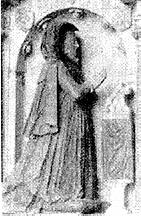 |
Indeed she must
have done, for when she died in May 1620, aged 93, she had lived to see 367
living descendants – 16 children; 114 grandchildren; 228 great grandchildren;
and nine great-great grandchildren. Although she spent the last years of her
life at Marks Hall, she is buried next to her husband at Lenham in Kent.
Many
paintings of her exist usually with either wine glass or prayer book in her hand
and one of these can be seen in Colchester Castle Museum. A tablet monument to
her was removed from the Marks Hall church of St Margaret before its demolition in 1933 and was
re-sited in the Sacristy of the parish church here in Coggeshall.
|
|
| |
|
Sir Thomas
Honywood |
|
This was
Robert’s eldest son from his second marriage and he inherited Marks Hall from
his widowed mother in 1631. Although he was knighted by Charles I the following
year, he became a staunch Parliamentarian and in 1648 commanded a body of
militia which played a prominent part in the Siege of Colchester. After the
surrender of the Royalists to Fairfax, he was left in charge of the town with
orders to demolish the walls. In 1651 he became one of the Knights of Shire in
Cromwell’s parliament. Following the restoration of Charles II he was granted a
royal pardon. It is said that the lakes at Marks Hall were dug out by his
Roundhead troops whilst stationed there before the Siege of Colchester. Sir Thomas died
in 1666, aged 80 and left Marks Hall to his wife for life. She outlived their
oldest son who died childless so the estate passed to the second son, John, who
also died childless. Marks Hall then passed to another Robert Honywood, from the branch of
the family still living at Charing in Kent. He was a colonel of infantry, Deputy
Lieutenant of Essex and an M.P. and was responsible for much modernisation of
the house. |
|
|
|
General Sir
Philip Honywood
|
|
He became the
next incumbent of the property upon his father’s death, his two elder brothers
having pre-deceased him, and is probably the most well known and interesting of
all the Honywoods. He entered the army aged 25 and then spent many years of
service on the continent. He was promoted
to Lieutenant Colonel of the King's Own Regiment of Dragoons and fought at
the Battle of Fontenay in 1745. The following year he was wounded in the
shoulder by the Scots at Clifton Moor. Apparently he was not wearing his steel
skull cap and his life was saved only by the thickness of his giant pigtail.
Later on he commanded cavalry during the seven years war before finally being
promoted to General in 1760.
He
was responsible in 1764 for commissioning a very detailed map of the Marks Hall
estate, showing at that time three lakes, and for having built a new brick
church. Of all the family portraits probably the most famous is the one of
General Honywood, painted by Gainsborough, showing him on horseback, in scarlet
uniform and with sword drawn. General Philip Honywood died in 1782.
|
|
|
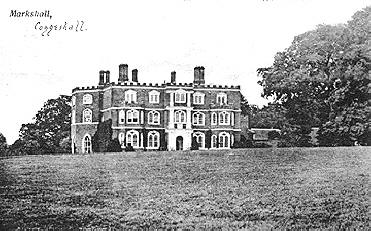 |
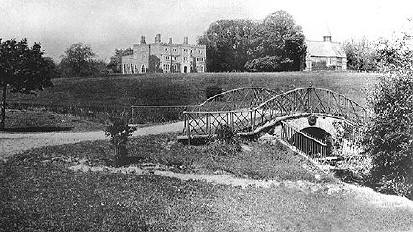 |
|
These pictures show the little
church of St Margaret and the fine mansion in the early 1900s. The little iron bridge is
still there, but the church was demolished in 1933 and the house in
the 1950s. See pictures below.
|
|
|
|
And finally |
|
The estate was
passed down through succeeding Honywoods until its final male owner, William
Philip Honywood who had married Frances Emma Phelips in 1849. They had no
children and, worried that the estate would pass to his brother Robert who
was a notorious gambler with heavy debts, William had a will drawn up to
protect the estate and prevent it from falling into Robert’s hands. The
terms were that the estate would be left in trust to his wife for her
lifetime should he pre-decease her. |
|
Within a week of the will being drawn up William caught a chill whilst out
hunting and died eight days later. Needless to say the will was contested but
the terms were upheld after various compromises. Frances never remarried and
continued to live at Marks Hall until her death in 1895. During her occupation
she was responsible for a comprehensive overhaul and restoration of the church
of St Margaret. In 1897 the whole of the estate was put up for auction and sold
to offset heavy debt, much of it incurred after legal costs when William’s will
was contested. And so on this sad note ended 290 years of Honywood family occupation at Marks Hall. |
|
|
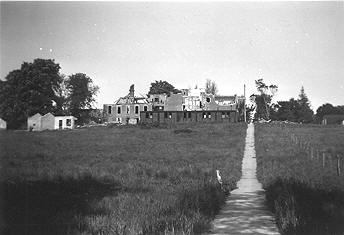 |
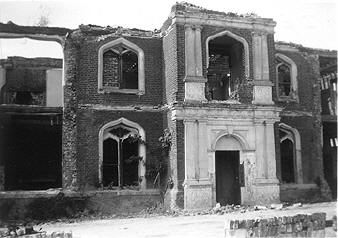 |
The demolition of Marks
Hall mansion in the 1950s
|
|
Back to
Heroes page |





